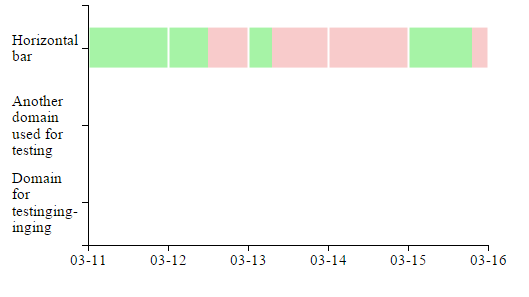var tempArray2 = [{date: "2017/3/11", ratio: 1}, {date: "2017/3/12", ratio: 0.5}, {date: "2017/3/13", ratio: 0.3}, {date: "2017/3/14", ratio: 0}, {date: "2017/3/15", ratio: 0.8}];
var margin = {
top: 20,
right: 20,
bottom: 40,
left: 80
},
width = 500 - margin.left - margin.right,
height = 300 - margin.top - margin.bottom;
barHeight = 40;
labelWidth = 0;
tempArray2.sort(function(a, b) {
return new Date(a.date) - new Date(b.date);
})
dateRange = Math.round((new Date(tempArray2[tempArray2.length - 1].date) - new Date(tempArray2[0].date)) / 1000 / 3600 / 24);
svg = d3.select('body')
.append("svg")
.attr("style", "width: 500px\; height: 300px\;");
var x = d3.scaleUtc().range([0, width])
.domain([toUTCDate(tempArray2[0].date), calculateDays(toUTCDate(tempArray2[tempArray2.length - 1].date), 1)]);
var y = d3.scaleBand()
.range([height, 0])
.padding(0.1)
.domain(["Domain for testinginginging", "Another domain used for testing", "Horizontal bar"]);
passBar = svg.selectAll(".passBar")
.data(tempArray2)
.enter();
passBar.append("rect")
.attr("class", "passBar")
.attr("height", barHeight)
.attr("width", function(d) {
return x(calculateDays(toUTCDate(d.date), d.ratio)) - x(toUTCDate(d.date));
})
.attr("y", y("Horizontal bar") + (y.bandwidth() - barHeight) / 2)
.attr("transform", function(d) {
return "translate(" + (margin.left + x(toUTCDate(d.date))) + ", 0)";
});
failBar = svg.selectAll(".failBar")
.data(tempArray2)
.enter();
failBar.append("rect")
.attr("class", "failBar")
.attr("height", barHeight)
.attr("width", function(d) {
return x(calculateDays(toUTCDate(d.date), 1 - d.ratio)) - x(toUTCDate(d.date));
})
.attr("y", y("Horizontal bar") + (y.bandwidth() - barHeight) / 2)
.attr("transform", function(d) {
return "translate(" + (margin.left + x(toUTCDate(d.date)) + x(calculateDays(toUTCDate(d.date), d.ratio)) - x(toUTCDate(d.date))) + ", 0)";
});
//add grid lines
svg.append("g")
.attr("class", "grid")
.attr("transform", "translate(" + margin.left + "," + height + ")")
.call(make_x_gridlines(dateRange)
.tickSize(-height)
.tickFormat("")
)
// always draw axis at last
svg.append("g")
.attr("transform", "translate(" + margin.left + "," + height + ")")
.attr("class", "xAxis")
.call(d3.axisBottom(x).ticks(dateRange).tickFormat(d3.utcFormat("%m-%d")))
.selectAll("text")
.style("text-anchor", "middle");
svg.append("g")
.attr("transform", "translate(" + margin.left + ", 0)")
.attr("class", "yAxis")
.call(d3.axisLeft(y))
.selectAll("text")
.attr("class", "cateName")
.style("text-anchor", "start")
.call(wrapText, margin.left - 13);
function calculateDays(date, number) {
date.setUTCDate(date.getUTCDate() + number);
return date;
}
function make_x_gridlines(tickTime) {
return d3.axisBottom(x).ticks(tickTime);
}
function toUTCDate(input) {
var tempDate = new Date(input);
return new Date(Date.UTC(tempDate.getFullYear(), tempDate.getMonth(), tempDate.getDate()));
}
function wrapText(text, width) {
text.each(function() {
var text = d3.select(this),
textContent = text.text(),
tempWord = addBreakSpace(textContent).split(/\s+/),
x = text.attr('x'),
y = text.attr('y'),
dy = parseFloat(text.attr('dy') || 0),
tspan = text.text(null).append('tspan').attr('x', x).attr('y', y).attr('dy', dy + 'em');
for (var i = 0; i < tempWord.length; i++) {
tempWord[i] = calHyphen(tempWord[i]);
}
textContent = tempWord.join(" ");
var words = textContent.split(/\s+/).reverse(),
word,
line = [],
lineNumber = 0,
lineHeight = 1.1, // ems
spanContent,
breakChars = ['/', '&', '-'];
while (word = words.pop()) {
line.push(word);
tspan.text(line.join(' '));
if (tspan.node().getComputedTextLength() > width) {
line.pop();
spanContent = line.join(' ');
breakChars.forEach(char => {
// Remove spaces trailing breakChars that were added above
spanContent = spanContent.replace(char + ' ', char);
});
tspan.text(spanContent);
line = [word];
tspan = text.append('tspan').attr('x', x).attr('y', y).attr('dy', lineHeight+'em').text(word);
}
}
var emToPxRatio = parseInt(window.getComputedStyle(text._groups[0][0]).fontSize.slice(0, -2));
text.attr("transform", "translate(-" + (margin.left - 13) + ", -" + lineHeight + ")");
function calHyphen(word) {
tspan.text(word);
if (tspan.node().getComputedTextLength() > width) {
var chars = word.split('');
var asword = "";
for (var i = 0; i < chars.length; i++) {
asword += chars[i];
tspan.text(asword);
if (tspan.node().getComputedTextLength() > width) {
if (chars[i - 1] !== "-") {
word = word.slice(0, i - 1) + "- " + calHyphen(word.slice(i - 1));
}
i = chars.length;
}
}
}
return word;
}
});
function addBreakSpace(inputString) {
var breakChars = ['/', '&', '-']
breakChars.forEach(char => {
// Add a space after each break char for the function to use to determine line breaks
inputString = inputString.replace(char, char + ' ');
});
return inputString;
}
}
svg {
width: 100%;
height: 100%;
position: center;
}
.passBar {
fill: #a6f3a6;
}
.failBar {
fill: #f8cbcb;
}
.grid line {
stroke: white;
stroke-width: 2px;
}
.grid path {
stroke-width: 0;
}
.xAxis {
font-size: 15px;
shape-rendering: crispEdges;
}
.yAxis {
font-size: 15px;
shape-rendering: crispEdges;
}
<script src="https://d3js.org/d3.v4.min.js"></script>
<body></body>



divon top of your graph at just the right position, but apart from that you would have to break the lines manually. – Quintanadivwith fixed positioning completely separate from the actual graph. That is, first you create the graph and then you adddivs for the labels that are not part of the SVG, thus avoid having to useforeignObject. – Quintana